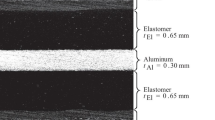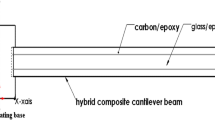Abstract
The increasing utilization of fiber-reinforced thermoplastics (FRTPs) as a substitute for metal in load-bearing structures poses challenges related to NVH issues arising from frequency variations and reliability concerns stemming from fiber dispersion within the resin matrix. In this study, the steel automobile seat beam serves as a benchmark for comparison. FRTP beams are designed and fabricated using two distinct processes: compression molding and injection over-molding. Subsequently, their modal frequency and reliability are meticulously analyzed. Experimental investigations are conducted to explore the influence of various factors, including the combination of laminates and ribs, as well as the stacking sequence of laminates, on the modal frequency. The findings reveal that the modal frequency and vibration mode are subject to alterations based on the fiber type, beam material, and laminate stacking sequence. Notably, in comparison to the steel benchmark, the first-order frequency of the FRTP beam in this study experiences a 6.59% increase while simultaneously achieving a weight reduction of 32.42%. To assess reliability, a comprehensive analysis is performed, considering a six-fold standard deviation. This analysis yields the permissible range of fluctuation for material elastic constants, bending performance, and frequency response. Encouragingly, the FRTP beams meet the required reliability criteria. These results provide valuable insights for comprehending the stiffness-dependent response and effectively controlling structural performance when implementing FRTP for weight reduction purposes.















Similar content being viewed by others
Abbreviations
- CF:
-
Carbon fiber
- CF30-PA6:
-
Continuous 30% volume fraction carbon fiber-reinforced PA6
- FRTP:
-
Fiber-reinforced thermoplastics
- GF:
-
Glass fiber
- GF30/PA6:
-
Discontinuous 30% volume fraction glass fiber-reinforced PA6
- PA6:
-
Polyamide 6
References
Lin, Y., Min, J., Teng, H., et al.: Flexural performance of steel–FRP composites for automotive applications. Automot. Innov. 3(3), 16 (2020)
Zhu, C., Zhu, P., Liu, Z., et al.: Prediction of the elastic properties of a plain woven carbon fiber-reinforced composite with internal geometric variability. Automot. Innov. 1(2), 11 (2018)
Kwak, D., Jeong, J., Cheon, J., et al.: Optimal design of composite hood with reinforcing ribs through stiffness analysis. Compos. Struct. 38(1), 351–359 (1997)
Lee, J.M., Min, B.J., Park, J.H., et al.: Design of lightweight CFRP automotive part as an alternative for steel part by thickness and lay-up optimization. Materials. 12(14), 2309 (2019)
Sureshkumar, M., Tamilselvam, P., Kumaravelan, R., et al.: Design, fabrication, and analysis of a hybrid fiber composite monoleaf spring using carbon and E-glass fibers for automotive suspension applications. Mech. Compos. Mater. 50(1), 115–122 (2014)
Yang, X., Sun, L., Zhang, C., et al.: Design and optimization of composite automotive hatchback using integrated material-structure-process-performance method. Appl. Compos. Mater. 25, 1455–1475 (2018)
New plastics report shows viable market for recycled plastic bumpers. PT Plastics Technology Web. https://www.ptonline.com/news/new-plastics-report-shows-viable-market-for-recycled-plastic-bumpers. Accessed 22 May 2019
Sherman, L.M.: The new lightweigts: Injection molded “hybrid” composites spur automotive innovation. Plast. Tech. 58(11), 27–31 (2012)
Wei, J., Sun, L., Lv, W., et al.: Integrated design and experimental verification of assembly fiber-reinforced thermoplastic plastics (AFRTP) automobile seat beams. Compos. Part B-Eng. 220(8), 108968 (2021)
SpriForm-Combined thermoforming/injection molding process for manufacturing complex parts. https://max.book118.com/html/2019/0815/5201041214002114.shtm. Accessed 22 Aug 2019
Schuck, M.: New processes for large scale automotive production of composite applications. Sampe. J. 48(1), 22–28 (2012)
Shao, S., Miki, M., Murotsu, Y.: Optimum: fiber orientation angle of multiaxially laminated composites based on reliability. Trans. Jpn. Soc. Mech. Eng. 57(5), 919–920 (2015)
Akkerman, R., Bouwman, M., Wijskamp, S.: Analysis of the thermoplastic composite over-molding process: interface strength. Front Mater. 7, 1–16 (2020)
Fiorotto, M., Lucchetta, G.: Experimental investigation of a new hybrid molding process to manufacture high-performance composites. Int. J. Mater. Form. 6, 179–185 (2013)
Fu, L., Zhang, M., Zhai, Z., Jiang, F.: The influence of preheating temperature on the mechanical properties of injection-overmolded hybrid glass fiber-reinforced thermoplastic composites. Polym. Test. 105, 107425 (2022)
Aurrekoetxea, J., Castillo, G., Cortes, F., Sarrionandia, M.A., Urrutibeascoa, I.: Failure of multimaterial fusion bonding interface generated during over-injection molding/thermoforming hybrid process. J. Appl. Polym. Sci. 102, 261–265 (2006)
Giusti, R., Lucchetta, G.: Modeling the adhesion bonding mechanism in over-molding hybrid structural parts for lightweight applications. Key Eng. Mater. 611–612, 915–921 (2014)
Chetan, G.B., Reddy, M.Y.: Comparative evaluation of four office reconditioning methods for orthodontic stainless steel brackets on shear bond strength—an in vitro study. Ann. Essen. Dent. 3, 6–13 (2011)
Heckert, A., Zaeh, M.F.: Laser surface pre-treatment of aluminium for hybrid joints with glass fibre reinforced thermoplastics. Phys. Proc. 56, 1171–1181 (2014)
Izadi, O., Mosaddegh, P., Silani, M., Dinari, M.: An experimental study on mechanical properties of a novel hybrid metal–polymer joining technology based on a reaction between isocyanate and hydroxyl groups. J. Manuf. Process. 30, 217–225 (2017)
Liebsch, A., Koshukow, W., Gebauer, J., Kupfer, R., Gude, M.: Overmoulding of consolidated fibre-reinforced thermoplastics-Increasing the bonding strength by physical surface pre-treatments. Proc. CIRP. 85, 209–214 (2020)
Nagy, L.I.: Static analysis via substructuring of an experimental vehicle front-end body structure. Publication of Norwegian Geotechnical Institute, Norway (1974)
Duarte, A.P.C., Saez, A.D., Silvestre, N.: Comparative study between XFEM and Hashin damage criterion applied to failure of composites. Thin Wall Struct. 115(7), 277–288 (2017)
Cmab, C., Vap, D., Csb, C.: Machining induced damage in orthogonal cutting of UD composites: FEA based assessment of Hashin and Puck criteria. Proc. CIRP. 82, 332–337 (2019)
Mohammed, M.A., Tarfaoui, M.: A progressive damage modelling of glass/epoxy cylindrical structure subjected to low-velocity impact. Eng. Fail. Anal. 134, 106036 (2022)
Jan, K.: Three-parameter Weibull distribution with upper limit applicable in reliability studies and materials testing. Microelectron. Reliab. 137, 114769 (2022)
Acknowledgements
This work was supported by the National Natural Science Foundation of China [Nos. 52072019, U1664250 and 51575023].
Author information
Authors and Affiliations
Contributions
Lingyu Sun: Conceptualization, Methodology, Supervision. Junlei Wei: Data curation, Writing-Original draft preparation, Methodology, Writing-Reviewing and Editing. Xinli Gao: Methodology, Writing-Reviewing and Editing. Wenfeng Pan: Writing-Reviewing and Editing. Jiaxin Wang: Writing-Reviewing and Editing. Jinxi Wang: Writing-Reviewing and Editing.
Corresponding author
Ethics declarations
Conflict of interest
The authors declare that they have no known competing financial interests or personal relationships that could have appeared to influence the work reported in this paper.
Rights and permissions
Springer Nature or its licensor (e.g. a society or other partner) holds exclusive rights to this article under a publishing agreement with the author(s) or other rightsholder(s); author self-archiving of the accepted manuscript version of this article is solely governed by the terms of such publishing agreement and applicable law.
About this article
Cite this article
Wei, J., Sun, L., Gao, X. et al. Frequency and Reliability Analysis of Load-Bearing Composite Beams. Automot. Innov. 7, 194–207 (2024). https://doi.org/10.1007/s42154-023-00233-4
Received:
Accepted:
Published:
Issue Date:
DOI: https://doi.org/10.1007/s42154-023-00233-4




